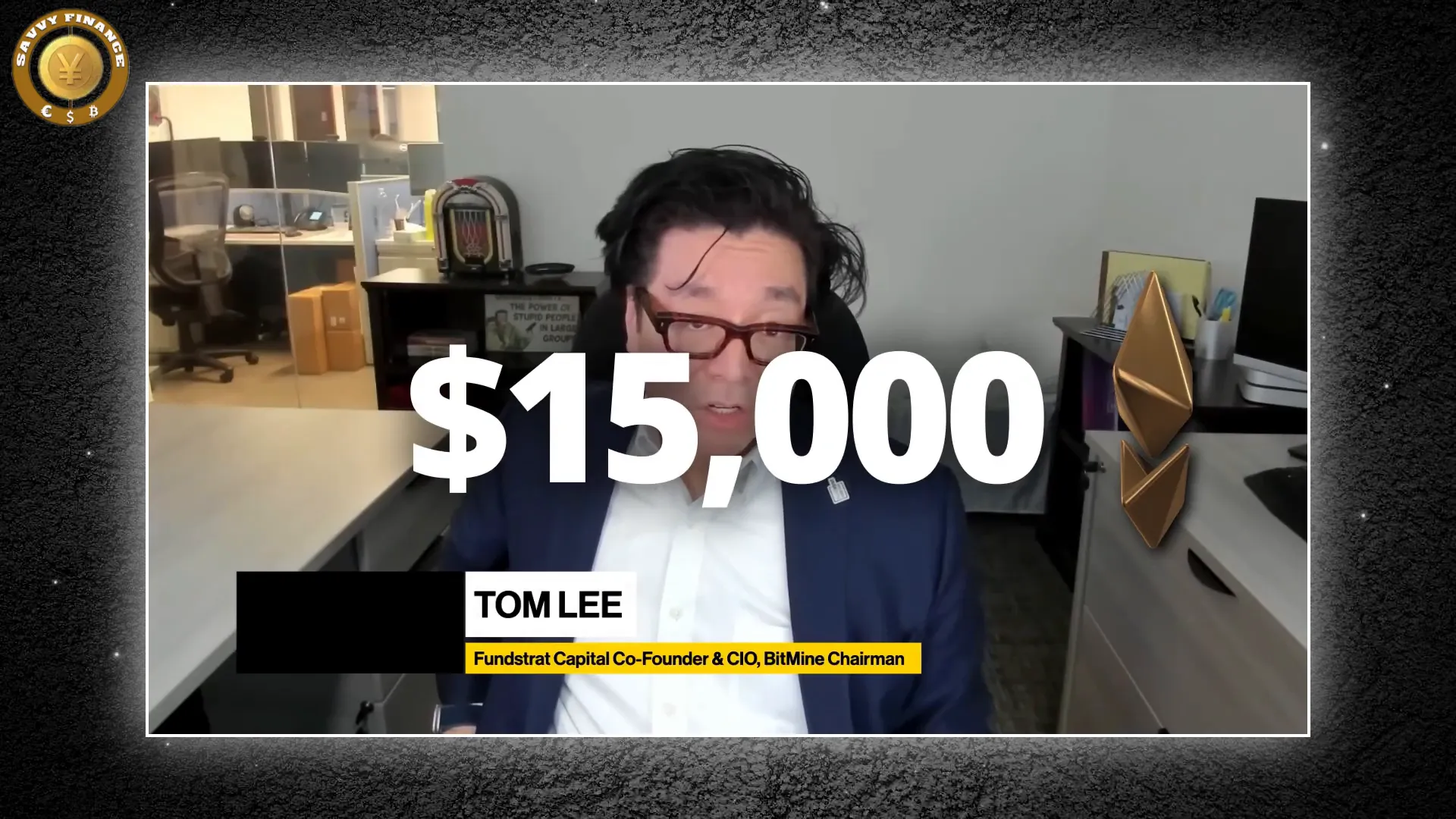
If you’re watching the cryptocurrency market closely, you’ve probably heard a lot about Bitcoin’s dominance. But what if the real opportunity lies with Ethereum? Tom Lee, a renowned analyst and chairman of Bitmind, lays out a compelling case for why Ethereum might be on the verge of a massive revaluation—and why savvy investors should pay attention.
In this article, we’ll break down Lee’s detailed analysis, exploring Ethereum’s unique position in the crypto ecosystem, its potential price targets, and how stablecoins and institutional interest are reshaping the landscape. Whether you’re a crypto enthusiast or just curious about how blockchain technology is evolving, this is a must-read.

Table of Contents
- Ethereum’s Price Potential: From $4,000 to $15,000 and Beyond
- Why Ethereum Is the Smart Contract Platform to Watch
- Institutional Strategies: How Bitmind Is Leading the Charge
- Comparing Ethereum and Bitcoin: Complementary, Not Competing
- Regulatory Landscape and Institutional Momentum
- Why Ethereum at $3,000 Could Be the Opportunity of the Decade
- What’s Next for Ethereum and Cryptocurrency Markets?
- Join the Conversation
Ethereum’s Price Potential: From $4,000 to $15,000 and Beyond
Tom Lee shares some ambitious price targets for Ethereum, informed by Fundstrat’s digital assets research led by Sean Farrell. Here’s the gist:
- Near-term target: $4,000 before the end of the month, according to technical strategist Mark Newton.
- Year-end forecast: $10,000 to $15,000, based on valuation multiples and network usage.
Lee emphasizes that these aren’t just speculative guesses. They’re grounded in a valuation framework comparing Ethereum to Circle’s USDC stablecoin issuer, which commands a staggering 130x EBITDA multiple. Applying a similar logic to Ethereum’s network utility suggests a price closer to $15,000 per ETH.
Breaking above $5,000 would mark a decisive all-time high and signal a new phase of growth for Ethereum, but Lee believes that’s just the beginning.

Why Ethereum Is the Smart Contract Platform to Watch
Unlike Bitcoin, which Lee calls “digital gold” and a store of trust, Ethereum is a programmable blockchain that supports smart contracts and tokenized assets. This functionality positions Ethereum as the backbone for a new generation of decentralized applications (dApps) and financial infrastructure.
Lee highlights a critical moment for Ethereum, calling it the “ChatGPT moment” for crypto—an inflection point where stablecoins have changed Wall Street’s perception of crypto’s utility. Banks and corporate treasuries are now embracing stablecoins as operational tools, with Ethereum as the primary infrastructure supporting them.
For example, Citigroup has publicly expressed interest in creating a stablecoin to manage deposit bases and improve settlement efficiency. This institutional adoption is a game-changer, pushing Ethereum into the spotlight as a compliant, scalable platform suitable for real-world financial applications.

The Role of Layer Ones and Layer Twos
Ethereum’s scalability challenges have been well-documented, but Lee remains confident it can keep up with demand. The key lies in creating the right incentives and balance between layer one (the base Ethereum blockchain) and layer two scaling solutions. Treasury companies and staking mechanisms are playing essential roles in this ecosystem, generating yield and supporting network growth.
Moreover, renewed interest in Ethereum fuels innovation, much like how ChatGPT sparked a wave of AI startups. Lee expects this momentum to unleash new applications and use cases that further solidify Ethereum’s dominance.

Institutional Strategies: How Bitmind Is Leading the Charge
Tom Lee isn’t just theorizing about Ethereum’s potential. As chairman of Bitmind, an Ethereum-focused corporate treasury firm, he’s actively executing a strategy that mirrors MicroStrategy’s Bitcoin accumulation—but with Ethereum at the center.
Bitmind uses equity markets and staking income to increase Ethereum holdings per share, effectively amplifying exposure to ETH appreciation while generating cash flow. For instance, Bitmind initially funded its treasury with $250 million worth of ETH and then doubled that amount within three days by raising additional capital.
This approach highlights a new blueprint for enterprise-level capital management in crypto, taking advantage of market volatility and institutional demand.
Comparing Ethereum and Bitcoin: Complementary, Not Competing
Lee draws a clear distinction between Bitcoin and Ethereum, viewing them as complementary assets rather than rivals:
- Bitcoin: The ultimate form of trust and digital gold, valued for its stability and scarcity. It serves as a monetary asset with a theoretical valuation ceiling near $1 million if it matches gold’s market cap.
- Ethereum: The largest smart contract platform, enabling tokenization of real-world assets, decentralized finance, and programmable money. It’s positioned to become the digital settlement layer for a wide range of applications, including AI-driven pricing and microtransactions.
Ethereum’s ability to store and manage real-world assets on-chain is a killer app that Bitcoin cannot replicate by design. This functional difference drives Ethereum’s unique growth potential.

Regulatory Landscape and Institutional Momentum
While regulatory uncertainty remains, Lee is optimistic about the trajectory of crypto regulation. He notes that recent improvements in Washington have been significant compared to the past decade, and that legislation can always be adjusted through executive orders or reintroduced bills.
The financial industry’s growing interest in crypto, especially stablecoins, means that Wall Street is becoming a key player in shaping future blockchain policy. This institutional influence will likely further legitimize Ethereum’s role in capital markets, making it a safer and more attractive investment over time.
Why Ethereum at $3,000 Could Be the Opportunity of the Decade
If you believe we’re on the cusp of a massive revaluation of smart contract platforms and the crypto rails that will support the next generation of finance, then Ethereum at current levels (around $3,000) might be a once-in-a-decade opportunity.
Lee’s analysis combines network fundamentals, institutional adoption, and innovative treasury management strategies to paint a picture of Ethereum as a deeply undervalued asset with enormous upside potential.
Whether you’re a long-term believer in blockchain technology or a trader seeking asymmetric returns, Ethereum’s evolving role in the financial ecosystem deserves your attention.

What’s Next for Ethereum and Cryptocurrency Markets?
The convergence of Wall Street, stablecoins, and smart contract innovation is creating a new paradigm for crypto assets. As institutional capital flows into Ethereum and regulatory clarity improves, we can expect:
- Increased adoption of Ethereum-based financial products and stablecoins.
- Continued innovation in layer two scaling and decentralized applications.
- Potential for Ethereum to become the backbone of tokenized real-world assets and AI-driven financial services.
- Price movements that could see Ethereum surpass $10,000 or even $15,000 by year-end.
Bitcoin will remain a key asset as digital gold, but Ethereum’s functional utility and institutional embrace position it for outsized growth in the years ahead.
Join the Conversation
Do you believe Ethereum will hit $15,000 this year? How do you see the relationship between cryptocurrency, bitcoin, and Ethereum evolving? Share your thoughts and insights to keep this exciting discussion going.
Stay informed with deep-dive analyses and updates to navigate the rapidly changing crypto landscape.
Cryptocurrency, Bitcoin, and the Unstoppable Rise of Ethereum: Insights from Tom Lee. There are any Cryptocurrency, Bitcoin, and the Unstoppable Rise of Ethereum: Insights from Tom Lee in here.
